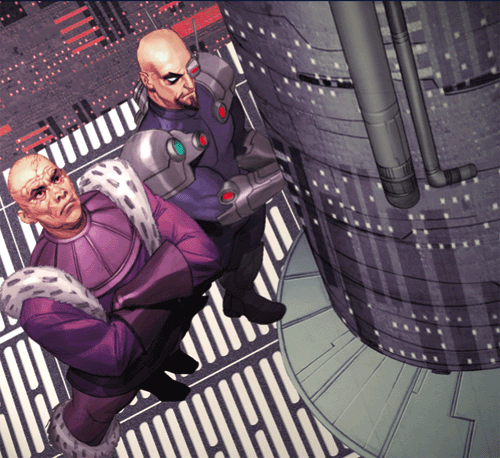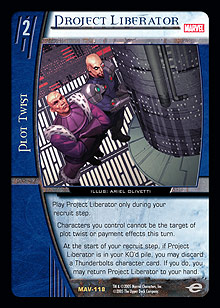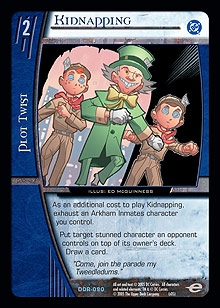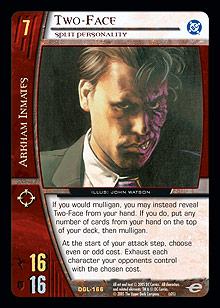
To quote William Wallace (the Mel Gibson version, at least):
FREEEEEEEEEEEEEEEEDOOOOOOOOOOOMMMMMM!!!!!
Yes, true believers . . . yours truly is finally free from audit tyranny. There is much joy and celebration in the Barnes household as I finally get to return to the job in Forensics (which I love dearly) and reasonable workweeks. Between my release from accounting captivity, my main man Shane Wiggans’s second place finish at PC Atlanta, and Tim Batow’s new pair of platform shoes, things are looking up in a big way.
Liberation . . . Liberation . . . It’s Time for Liberation!
My original plan was to feature Prison Break as this week’s theme card (for obvious reasons). Unfortunately, aside from the nifty combo with Bat’s Belfry, I couldn’t think of any grand uses for Prison Break. But I really wanted to feature the Arkham Inmates (they have always been one of my favorite teams to play), so I decided to brainstorm on cards that might help the team while still tying in with my own personal “Prison Break.”
One major problem with the Inmates is that they are very vulnerable to disruption. Sure, they have some of the best board control cards in the game: against most aggro curve decks, the Arkham characters will dominate the board because they can KO opposing characters with great efficiency. However, the Inmates run into major problems when paired against characters that possess off-initiative tricks. Decks like Common Enemy and Teen Titans just abuse them horribly because they can go aggressive on their initiative, and then completely shut down any attacks by the Arkham characters on off-initiative turns.
Recent sets have brought us answers for a lot of these tricks with cards like BWA HA HA HA HA! and Fatality, Emerald Assassin. However, as nifty as they are, they don’t really assist the Arkham Inmates much because they’re either team-stamped or suited for strategies that can’t be incorporated into Arkham board control . . . with the possible exception of Project Liberator.

 Project Liberator is technically team-stamped to the Thunderbolts. However, much like Null Time Zone, its effect is not strictly limited to its team stamp. As such, Project Liberator ensures that your characters cannot be targeted by any plot twist or payment effects this turn (regardless of which team they are on). Of course, that also refers to your plot twists and payment effects as well as your opponents’. You may not have to fear Roy Harper ◊ Arsenal, but neither can you Press the Attack. Finishing Move is no good, but Lanterns in Love won’t bring any of your guys back. And System Failure may be useless against you, but it’s kind of a moot point since Savage Beatdown won’t work, either. Suffice to say, it’s a bit of a double-edged sword.
Project Liberator is technically team-stamped to the Thunderbolts. However, much like Null Time Zone, its effect is not strictly limited to its team stamp. As such, Project Liberator ensures that your characters cannot be targeted by any plot twist or payment effects this turn (regardless of which team they are on). Of course, that also refers to your plot twists and payment effects as well as your opponents’. You may not have to fear Roy Harper ◊ Arsenal, but neither can you Press the Attack. Finishing Move is no good, but Lanterns in Love won’t bring any of your guys back. And System Failure may be useless against you, but it’s kind of a moot point since Savage Beatdown won’t work, either. Suffice to say, it’s a bit of a double-edged sword.
So, if Project Liberator is such a drawback, why am I interested in putting it in an Arkham Inmates deck? Quite simply, the benefits outweigh the costs. It’s worth losing the ability to target my own characters if I can give the Inmates a fighting chance against decks that would normally crush them horribly. Besides, as we will find, there are several cards that can support our cause without targeting our characters. Follow me as we help the lovable loonies of Arkham Asylum break Project Liberator.
The Build
 As per usual, we’ll start out with our four requisite copies of our theme card.* Of course, Project Liberator is going to restrict our options somewhat, since we can’t target our own characters on the turns we play it. As such, we need to develop an offensive strategy that can work around the limitation. One great solution is to play plot twists that don’t attempt to boost our characters’ ATK, but instead lower an opposing character’s DEF. An example that immediately leaps to mind is No Man Escapes the Manhunters. This card—which will no doubt become a fixture in many Silver Age decks—has the benefit of targeting opposing characters. In addition, it provides a turn-based effect, meaning that it can be played at any time and still apply the effect to the targeted character. This can be invaluable for responding to cards like AIDA, which would normally prevent No Man Escapes the Manhunters from working its mojo. Finally, the ability to move a character out of the hidden area can be invaluable when dealing with decks whose characters live and die in the hidden area (such as AGL Rush).
As per usual, we’ll start out with our four requisite copies of our theme card.* Of course, Project Liberator is going to restrict our options somewhat, since we can’t target our own characters on the turns we play it. As such, we need to develop an offensive strategy that can work around the limitation. One great solution is to play plot twists that don’t attempt to boost our characters’ ATK, but instead lower an opposing character’s DEF. An example that immediately leaps to mind is No Man Escapes the Manhunters. This card—which will no doubt become a fixture in many Silver Age decks—has the benefit of targeting opposing characters. In addition, it provides a turn-based effect, meaning that it can be played at any time and still apply the effect to the targeted character. This can be invaluable for responding to cards like AIDA, which would normally prevent No Man Escapes the Manhunters from working its mojo. Finally, the ability to move a character out of the hidden area can be invaluable when dealing with decks whose characters live and die in the hidden area (such as AGL Rush).
Of course, as good as No Man Escapes the Manhunters will be for our deck, Glass Jaw will be even better. I recall my early JLA Sealed Pack tournaments playing this card. The consensus of most of the players was that Glass Jaw could be amazing in an Arkham KO deck. Given the tendency of Arkham Inmates characters to do cruel things to opposing defenders when they are exhausted, Glass Jaw is a veritable torture device to our opponents’ characters. And, much like No Man Escapes the Manhunters, its effect is also turn-based.
Finally, we can bypass targeting limitations by playing cards that confer bonuses to all of our characters. One card that falls squarely into this category is Fear and Confusion, which, along with Glass Jaw, helps ensure that none of our opponents’ characters will be ready during turns where we control the initiative. Given the tricks we have in store for our opponents’ exhausted characters, they might not even have a character on the board by the time we are done.
 Of course, every good board control deck needs some board control cards. Our first and best choice is Kidnapping, which is simply the best board removal effect in the game (though certainly not the most viable). Much like Finishing Move, Kidnapping clears the board of a stunned character . . . and of course, our opponent will usually end up drawing that character again on the next turn, which can severely impede the progress of his or her draw, since he or she will miss out on a card that otherwise would have been drawn. Throw in the fact that we get to draw a card for our opponent’s trouble, and Kidnapping becomes absolutely amazing. Of course, the Inmates have another winner of a board control card in Smiles, Everyone!. As I mentioned earlier, the Arkham Inmates have a plethora of vicious effects that hinge upon an opponent’s exhausted characters. Smiles, Everyone! is one of the nastiest of the group, building in a KO effect whenever an exhausted character becomes stunned. Cruel? Certainly. But tons of fun for the Arkham player!
Of course, every good board control deck needs some board control cards. Our first and best choice is Kidnapping, which is simply the best board removal effect in the game (though certainly not the most viable). Much like Finishing Move, Kidnapping clears the board of a stunned character . . . and of course, our opponent will usually end up drawing that character again on the next turn, which can severely impede the progress of his or her draw, since he or she will miss out on a card that otherwise would have been drawn. Throw in the fact that we get to draw a card for our opponent’s trouble, and Kidnapping becomes absolutely amazing. Of course, the Inmates have another winner of a board control card in Smiles, Everyone!. As I mentioned earlier, the Arkham Inmates have a plethora of vicious effects that hinge upon an opponent’s exhausted characters. Smiles, Everyone! is one of the nastiest of the group, building in a KO effect whenever an exhausted character becomes stunned. Cruel? Certainly. But tons of fun for the Arkham player!
Next, let’s look at character search. One of the problems with the mono-Arkham deck is that it has a severe lack of credible search or deck-cycling cards. While the JLA set certainly upped the caliber of the character cards, it did little to improve the search or cycling situation. We really don’t have any good answers for this problem. However, we do have some generic search cards that can fill in. Since this is essentially a single-team deck, my beloved Enemy of My Enemy card won’t work here. So we’ll rely on our backup of Secret Origins, which, to be fair, is really only effective on turns when you don’t control the initiative. And against decks that don’t play on curve, it can be downright useless. However, it is a suitable search card, and ensures that we can get at least some level of character representation each turn (even if it isn’t the drop that we’d like). Hopefully, we won’t have to rely on Secret Origins too much, since having multiple drops for each turn and the extra draw power of Kidnapping will help us to hit our curve throughout the game.
Our final plot twist choice requires a bit of explanation, since it sort of flies in the face of our deck strategy. Our primary reason for playing Project Liberator is to protect our characters on our initiatives from effects that could hamper our attacks. On the off-initiative turns, however, we probably won’t be playing Project Liberator very often. This leaves us free to add some defensive tricks to our deck. One of the best, in my opinion, is Nasty Surprise. Its effect speaks for itself, but it’s worth noting how potent the card can be in this deck, since it combos very well with many of the characters and plot twists. There is nothing more heartbreaking for our opponent than to attempt a “safe” attack down the curve, only to be thwarted by a Nasty Surprise, and then have his or her character sent packing with Kidnapping.
As far as the characters go, we have the usual assortment of lovable lunatics. On turn 1, we have a former Breaking Ground theme card, Harley Quinn. While not quite as strong as she was in unison with Lost City, she still possesses a reinforcement effect that helps us get through the early turns relatively unscathed. And if we don’t manage to draw her until the later turns, she can still be useful from the hand as a power-up in a time of need.
On turn 2, we have a couple of characters to introduce. Our preferred 2-drop is the infamous Puppet Master. While not an Arkham Inmate, he’s still a pretty nasty guy and all-around exhausting villain. If we can get him on the board in the early turns, he can dramatically cut down the number of opportunities that our opponents have to attack. And if we manage to achieve board control, then it is very possible that we could eliminate opposing attacks altogether (assuming that our opponent stays on curve). Our backup 2-drop, Mr. Zsasz, is a little less well-known, but still has some definite possibilities. With an aggressive deck like ours, Mr. Zsasz can quickly grow in size. In addition, he subs as a marginal 3-drop with his boost effect, which can be really good against decks that have potent 1-drop characters, like Squadron No Hand or AGL Rush.
 On turn 3, we would like to see Charaxes, Drury Walker every single game. One of the saving graces of the Arkham Inmates team is that they have some absolutely brutal exhaustion combos that allow Charaxes to become a KO machine. With Fear and Confusion and Glass Jaw at our disposal, Charaxes should be capable of dispatching opposing 4- and 5-drops with ease. Giving up breakthrough for the ability to demolish our opponent’s board is a trade that I’ll take any day of the week.
On turn 3, we would like to see Charaxes, Drury Walker every single game. One of the saving graces of the Arkham Inmates team is that they have some absolutely brutal exhaustion combos that allow Charaxes to become a KO machine. With Fear and Confusion and Glass Jaw at our disposal, Charaxes should be capable of dispatching opposing 4- and 5-drops with ease. Giving up breakthrough for the ability to demolish our opponent’s board is a trade that I’ll take any day of the week.
Turn 4 is another treasure trove of disruptive characters for us. As far as exhaustion-based effects go, it’s hard to go wrong with Hush. His payment power can ensure that we’ll either be able to KO the defender with the help of Smiles, Everyone!, or that an already exhausted defender (thanks to Glass Jaw or Fear and Confusion) won’t be ready to dish out any attacks on the following turn. However, as good as Hush is, he’s really our second choice at this drop.
Gentlemen may prefer blondes, but I’ve always fancied redheads. That’s why our primary 4-drop is Poison Ivy, Pamela Isley. Poison Ivy recently had a couple of new versions added to the Vs. System, but it really is hard to beat the original. Although she boasts sub-par stats, her effect is absolutely insane! If she manages to stun an opposing character while either attacking or defending, then the stunned character will not recover that turn, period! Children of the Atom and Lanterns in Love become completely useless in the face of her seductive charms. And if our opponent wants to keep around the character that Ivy stuns, he or she will have to live with the fact that the character will still be face down going into the next turn. Poison Ivy certainly gives a new context to the term “stunning beauty”!
Turn 5 is when we want to bring our big men out to play. Up until the release of the JLA set, the biggest and best Arkham Inmates 5-drop was undoubtedly Killer Croc, Waylon Jones. Although he’s not much to look at defensively, he can take down pretty much every 5- and 6-drop in the game when he’s attacking. However, the JLA set brought us a character that is almost as big offensively as Killer Croc and much bigger defensively. There is little doubt that Scarecrow, Fearmonger (a.k.a., “The Original Nimrod Killa”) is one of the best 5-drops in the entire Vs. System. Not only is Scarecrow above the curve stat-wise with an impressive 10 ATK, but he also keeps getting bigger! If we are fortunate enough to play against a deck that has a character with a counter or two (or possibly if we still have our own Mr. Zsasz on the board), then Scarecrow (or another character that we control) can get a quick +1 ATK / +1 DEF boost at the start of the combat phase. With a stun on turn 5, our Fearmonger quickly grows to the size of a 6-drop before we ever reach the sixth turn!
Since we’re on the subject of 6-drops, let’s look at our own choices here. Another one of the “coolest” characters in the game is Mr. Freeze. On offense, he can effectively replicate Hush’s effect of taking the character that he attacks out of play for the next turn. On defense, he’s a wall, pure and simple. With an impressive 13 DEF, most other 6-drops won’t be able to go through him without some help. Of course, Mr. Freeze is also great against those annoying effects that ready attackers (yes, I’m talking to you, Teen Titans Go!). Our backup at 6 is the big man himself, Bane, The Man Who Broke the Bat. While not the preferred play on 6, Bane has a little extra utility in this deck since he can act as either a 6-drop or a small 7-drop in a pinch (like when we control the initiative on 7 and have to use Secret Origins to hit our drop). But Bane does have a very nice KO effect that can net us some impressive board advantage if our smaller characters are able to attack up the curve . . . and that shouldn’t be too difficult when our “smaller characters,” like Scarecrow and Killer Croc, have the ATK power of 6-drops!
 Heads or tails, our character at 7 will always be a winner for us. is one of the most highly regarded 7-drops in the game. He fits exceptionally well into the exhaustion theme of our deck, since he will usually be able to exhaust at least half of the characters on our opponent’s side of the board during our initiative. And the 16 ATK / 16 DEF stats don’t hurt, either. But the bottom line is that Two-Face acts as the cleanup hitter to a veritable Murderer’s Row of characters from turns 3 through 7. And since our opponents won’t be able to rely on Mystical Paralysis or Roy Harper ◊ Arsenal to restrain our lunatics, it could get very ugly on those turns where we are able to attack and wreck our opponents’ boards.
Heads or tails, our character at 7 will always be a winner for us. is one of the most highly regarded 7-drops in the game. He fits exceptionally well into the exhaustion theme of our deck, since he will usually be able to exhaust at least half of the characters on our opponent’s side of the board during our initiative. And the 16 ATK / 16 DEF stats don’t hurt, either. But the bottom line is that Two-Face acts as the cleanup hitter to a veritable Murderer’s Row of characters from turns 3 through 7. And since our opponents won’t be able to rely on Mystical Paralysis or Roy Harper ◊ Arsenal to restrain our lunatics, it could get very ugly on those turns where we are able to attack and wreck our opponents’ boards.
Well, we are finally free from our deckbuilding exercise. Let’s set the Inmates loose on the Vs. System and see what kind of havoc they can wreak.
Liberated Lunatics (60 cards)
Characters (33)
4 Harley Quinn, Dr. Harleen Quinzel
4 Puppet Master
3 Mr. Zsasz, Victor Zsasz
4 Charaxes, Drury Walker
4 Poison Ivy, Pamela Isley
2 Hush, Mystery Man
4 Scarecrow, Fearmonger
1 Killer Croc, Waylon Jones
3 Mr. Freeze, Dr. Victor Fries
1 Bane, The Man Who Broke the Bat
3 Two-Face, Split Personality
Plot Twists (27)
3 Fear and Confusion
4 Glass Jaw
4 Kidnapping
4 Nasty Surprise
4 No Man Escapes the Manhunters
4 Project Liberator
2 Secret Origins
2 Smiles, Everyone!
The choice of initiatives really depends on the deck that you face. Against a deck like Teen Titans, you would probably prefer the even initiatives so that Charaxes, Drury Walker can take down Terra before she can start dropping locations on him every turn. And if your opponent takes a stun by attacking with Garth ◊ Tempest against Poison Ivy, Pamela Isley backed up by a Nasty Surprise, then you can pretty much call it game. Against more aggressive decks, odd initiatives are preferred because such decks tend to win on the fifth turn. If you can neutralize most of the opposing board with KO and board control effects without taking too much stun damage, then you should be able to let Mr. Freeze and Two-Face, Split Personality take control in the later turns.
The mulligan is almost always for Charaxes, since he is the card that really gets your strategy going. Also, don’t forget about Two-Face’s mulligan effect (like I always do!).
That’s all, folks! I’m off to enjoy my sweet, relaxing, audit-free life. But I’ll be back again for another go next week. In the meantime, if you have any questions, comments, or suggestions for me, feel free to send me an email at BigSpooky1@hotmail.com. I am currently in the process of clearing out a backlog of about a hundred emails that accumulated during the audit busy season. However, I look forward to talking tech with all of you now that I am free. Accounting is all well and good, but having the time to play some serious Vs. System now and then is where it’s at. And now it’s time to start prepping seriously for Silver Age and Pro Circuit San Francisco!
* To date, I think the only theme card that we haven’t played four copies of is The Joker, Emperor Joker. Isn’t it ironic that this fact would occur to me while featuring an Arkham deck?